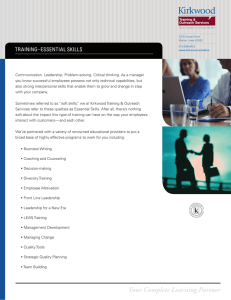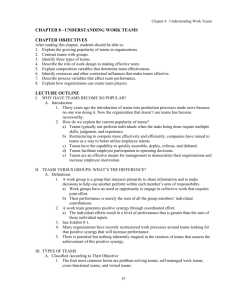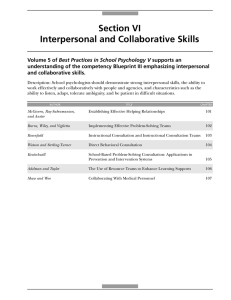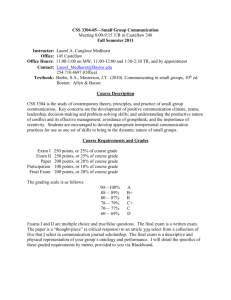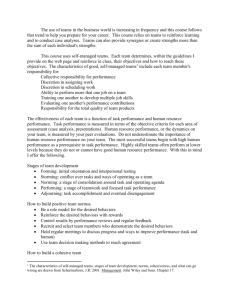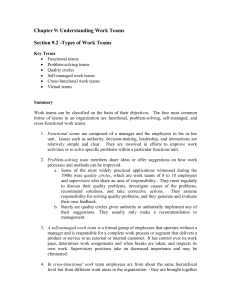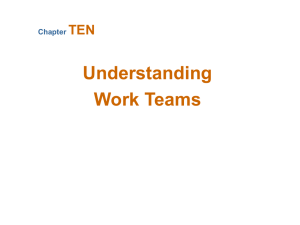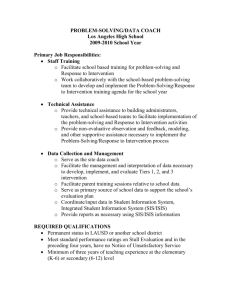Understanding Work Teams: Organizational Behavior Presentation
advertisement
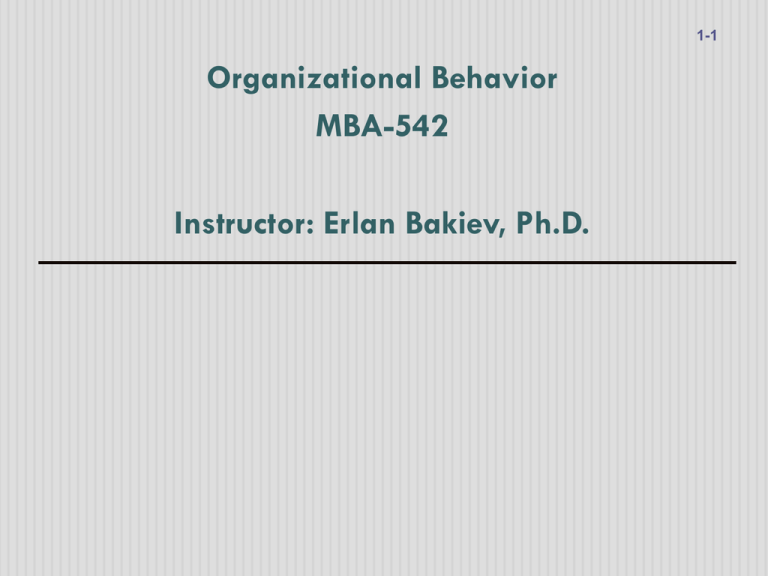
1-1 Organizational Behavior MBA-542 Instructor: Erlan Bakiev, Ph.D. 9-2 Essentials of Organizational Behavior, 11/e Stephen P. Robbins & Timothy A. Judge Chapter 9 Understanding Work Teams After studying this chapter, you should be able to: 9-3 1. Contrast groups and teams, and analyze the growing popularity of using teams in organizations. 2. Compare and contrast four types of teams. 3. Identify the characteristics of effective teams. 4. Show how organizations can create team players. 5. Decide when to use individuals instead of teams. 6. Show how the understanding of teams differs in a global context. Why Are Teams So Popular? 9-4 Increased competition forced restructuring for efficiency and effectiveness Teams: Better utilize employee talents Are more flexible and responsive to change Democratize and motivate Groups and Teams 9-5 Work Group – A group who interacts primarily to share information and to make decisions to help one another perform within each member’s area of responsibility Work Team – Generates positive synergy through coordinated effort; individual efforts result in a level of performance that is greater than the sum of those individual inputs Comparing Work Groups and Work Teams 9-6 Four Types of Teams 9-7 Problem-Solving Teams 9-8 Members often from the same department Share ideas or suggest improvements Rarely given authority to unilaterally implement any of their suggested actions Self-Managed Work Teams 9-9 10-15 employees in highly-related jobs Team takes on supervisory responsibilities: Work planning and scheduling Assigning tasks Operating decisions/actions Working with customers May select and evaluate members Effectiveness is situationally dependent Cross-Functional Teams 9-10 Members from same level, but diverse areas within and between organizations Exchange information Develop new ideas and solve problems Coordinate complex projects Development may be time-consuming due to complexity and diversity Virtual Teams 9-11 Computer technology ties dispersed team together Special challenges: Less social rapport More task-oriented Members less satisfied Key Components of Effective Teams 9-12 Context Composition Process Contextual Components 9-13 Presence of adequate resources Effective leadership and structure Climate of trust in the team Performance evaluation and reward system that reflects team contributions Team Composition Components 9-14 Abilities of members Technical expertise Problem-solving Interpersonal Personality Conscientious and open-minded Allocation of Roles Diversity Size of teams Member preferences Process Components 9-15 Common plan and purpose Specific goals Team efficacy Common mental models Low levels of conflict Minimized social loafing Turning Individuals Into Team Players 9-16 Selection – Need employees who have the interpersonal as well as technical skills Training – Workshops on problem-solving, communications, negotiation, conflict-management and coaching skills Rewards – Encourage cooperative efforts rather than individual ones Teams Aren’t Always the Answer: Three Tests 9-17 Complexity of Work: Can the work be done better by more than one person? Common Purpose: Does the work create a common purpose or set of goals for the people in the group that is more than the aggregate of individual goals? Interdependence: Are the members of the group interdependent? Global Implications 9-18 Teamwork is less pervasive in the United States. Self-managed teams may be difficult to introduce globally – power distance problems. Team cultural diversity creates difficulties in the short run. Implications for Managers 9-19 Common characteristics of effective teams: Have adequate resources, effective leadership, a climate of trust, and suitable reward system Composed of individuals with technical and interpersonal skills Work provides freedom, autonomy and opportunity to use skills Members are committed to a common purpose Keep in Mind… 9-20 Proper selection of members increases likelihood of effective teams Team should be constructed based on ability, skill, and applicable member traits given the situation Non-personal conflicts can lead to better team decisions Summary 9-21 1. Contrasted groups and teams and analyzed the growing popularity of using teams in organizations. 2. Compared and contrasted four types of teams. 3. Identified the characteristics of effective teams. 4. Showed how organizations could create team players. 5. Decided when to use individuals instead of teams. 6. Showed how the understanding of teams differed in a global context.
